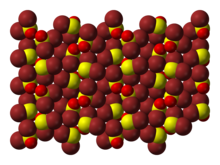
Back بروميد الثيونيل Arabic تیونیل برومید AZB Thionylbromid German Tionila bromido EO Bromuro de tionilo Spanish تیونیل برمید FA Bromure de thionyle French 臭化チオニル Japanese Thionylbromide Dutch Bromek tionylu Polish
| |||

| |||
| Names | |||
|---|---|---|---|
| IUPAC name
Thionyl bromide
| |||
| Other names
Sulfur oxy dibromide
| |||
| Identifiers | |||
3D model (JSmol)
|
|||
| ChemSpider | |||
| ECHA InfoCard | 100.007.332 | ||
| EC Number |
| ||
PubChem CID
|
|||
| UNII | |||
CompTox Dashboard (EPA)
|
|||
| |||
| |||
| Properties | |||
| SOBr2 | |||
| Molar mass | 207.87 g/mol | ||
| Appearance | colorless liquid | ||
| Density | 2.688 g/mL, liquid[1] | ||
| Melting point | −52 °C (−62 °F; 221 K) ; may include supercooling[1] | ||
| Boiling point | |||
| decomposes | |||
| Solubility | reacts in HBr, acetone, and alcohol soluble in benzene, toluene, ether | ||
| Structure | |||
| trigonal pyramidal | |||
| 1.47 D[1] | |||
| Hazards[2] | |||
| Occupational safety and health (OHS/OSH): | |||
Main hazards
|
Readily decomposes in air to toxic gases | ||
| GHS labelling: | |||
 
| |||
| Danger | |||
| H312, H314, H332 | |||
| P280, P305+P351+P338, P310 | |||
| Flash point | Non-flammable | ||
| Safety data sheet (SDS) | "External MSDS" | ||
| Related compounds | |||
Related compounds
|
SOCl2, SeOCl2; | ||
Except where otherwise noted, data are given for materials in their standard state (at 25 °C [77 °F], 100 kPa).
| |||
Thionyl bromide is the chemical compound SOBr2. It is less stable and less widely used than its chloride analogue, thionyl chloride, but engages in similar reactions.[3]
- ^ a b c d e Magee, Philip S. (1971). "The Sulfur–Bromine Bond". In Senning, Alexander (ed.). Sulfur in Organic and Inorganic Chemistry. Vol. 1. New York: Marcel Dekker. pp. 271–276. ISBN 0-8247-1615-9. LCCN 70-154612.
- ^ "Thionyl bromide". Sigma Aldrich.
- ^ Mundy, B. P. (2004). "Thionyl Bromide". In Paquette, E. (ed.). Encyclopedia of Reagents for Organic Synthesis. New York: J. Wiley & Sons. doi:10.1002/047084289X.rt098. ISBN 0471936235.

